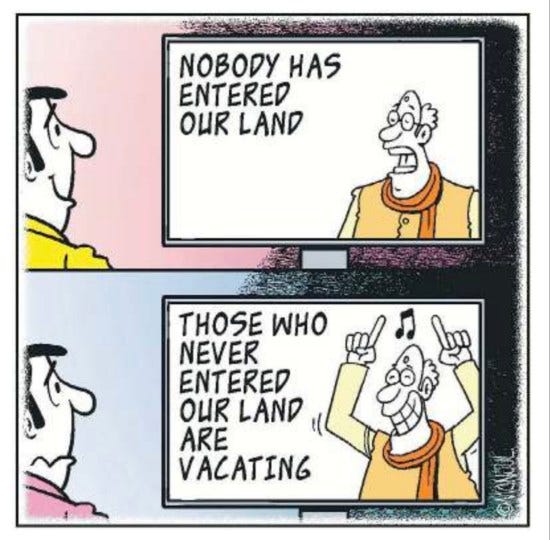"India has ceded territory to China... Status quo ante has been lost... China has redrawn LAC”
Scathing editorials across India call the Narendra Modi government’s bluff on the ‘Surender’ in Ladakh—and reaffirm the value of English print journalism

Editorials in India’s major English newspapers on the “mutual disengagement” that India and China have agreed upon, are nearly unanimous in their verdict: under “strong man” Narendra Modi, India has surrendered its territory to China.
The mature and considered reading of the newspapers is in marked contrast to TV news channels parroting the BJP-led NDA government line, relayed via WhatsApp.
Barring The Economic Times, the editorials unhesitatingly call out the failure of the Modi government in restoring the status quo ante in Ladakh, that is the position that existed on the ground before Chinese troops occupied Indian territory.
Deccan Herald, Bangalore
“In Galwan, why are we pulling back? Govt must explain what’s happening in Ladakh“
“There is little reason for India to draw satisfaction from events unfolding in Ladakh. Contrary to claims that India held its ground in the talks between National Security Adviser Ajit Doval and China’s foreign minister Wang Yi, it does seem that India has ceded territory to the Chinese.
“India’s stated position on the Galwan Valley is that this area is on the Indian side of the LAC. Then why has India pulled back 1.8 km from the face-off site here? And why did it agree to a ‘buffer zone’, again in what is Indian territory? Beijing has made a grand show of pulling back a bit. But it has gained territory overall in the ‘mutual disengagement process’. By agreeing to this farcical pullout, the Narendra Modigovernment seems unable to revere the Chinese land-grab in Ladakh.
Business Standard, Delhi
“Lessons of disengagement: China takes two steps forward, one step back“
“The de-escalation agreement clearly does not restore the status quo ante of April, before the Line of Actual Control (LAC) was effectively redrawn by the occupation of several patches of Indian territory by Chinese soldiers.
“A fair and honourable settlement should see both sides pulling back to the positions they held in April before China violated the LAC, but that is not what is happening. The implications of this are not difficult to see. China will have effectively redrawn the LAC by retaining chunks of Indian territory it has encroached upon.”
Deccan Chronicle, Hyderabad
The Asian Age, Delhi“China pullout: firmness, vigilance are both critical“
“The pullouts created a buffer zone between the two armies which in itself would be a desirable thing if it weren’t for the fact that the buffer zone lies within areas that India controlled along the LAC—in other words, what was Indian territory (in its perception) has been made a no-man’s land without a similar zone on the other side of the LAC. Notably, the Chinese have still not discussed their incursion at Pangong Tso Lake. The establishment fears the Chinese want to retains this, and are surrendering other areas in their “two steps forward, one step back” strategy.
Hindustan Times, Delhi
“India must remain careful: Disengagement is positive, but verify and be prepared“
“India must ensure complete restoration of status quo ante. China has violated past understandings; its statement contained a hint of continued belligerence, and there doesn’t appear to be a deal on it stepping back from the finger area in Pangong-Tso.”
The Times of India, Bombay
“Stepping back: India, China agree to disengage, but New Delhi must keep its guard up“
“The buffer zones themselves deny Indian troops access to patrolling points they have traditionally traversed. Beijing has also made large new territorial claims in eastern Bhutan bordering India’s Arunachal Pradesh, fulfilling which will require the Chinese to acquire the latter too. All this clearly shows that China will not relent on pressing India along the LAC. New Delhi, therefore, has to be prepared for a two-front war as any conflict with Beijing will likely draw in Islamabad as well.”
The Hindu, Madras
“The government should inform the country about the considered measures such as “buffer zones”, the patrolling-free period, and the reasons for the decision to pull back Indian troops in the areas of disengagement. The government must also continue to work towards its stated goal of restoring the “status quo ante” or the position of troops to the situation in April, before the mobilisation began. Else, prime minister Modi’s strong words at Leh will have little meaning.”

The really surprising editorial is in The Economic Times, the newspaper which reported the heat that was building up in Ladakh, as early as May 12.
The Economic Times, Delhi
“Welcome easing of tensions with China“
“What India needs is not a return to the status quo ante before June 15, but a more active, persistent campaign to pressure China to abandon its expansionists claims on neighbours’ territory and to settle its border with China. New Delhi appears to be finally evolving a China policy that acknowledges Beijing’s expansionist and mercantile tendencies.”
***
But the most succinct observation of the ‘Surender’ comes from Sushant Singh, the Indian Express editor, who along with Ajai Shukla of Business Standard, has done some stellar reporting.
In other words, the new reality which India has accepted is the one the Chinese have created i.e., the Chinese have achieved what they set out to.
***
Cartoon: courtesy Manjul/ Mid-Day
***
The veterans who unmasked the Chinese incursions
Stop showing satellite images, TV editors get a nudge
A well-travelled story that goes from Rediff to Washington Post
Press Club of India tears into attack on Press Trust of India



